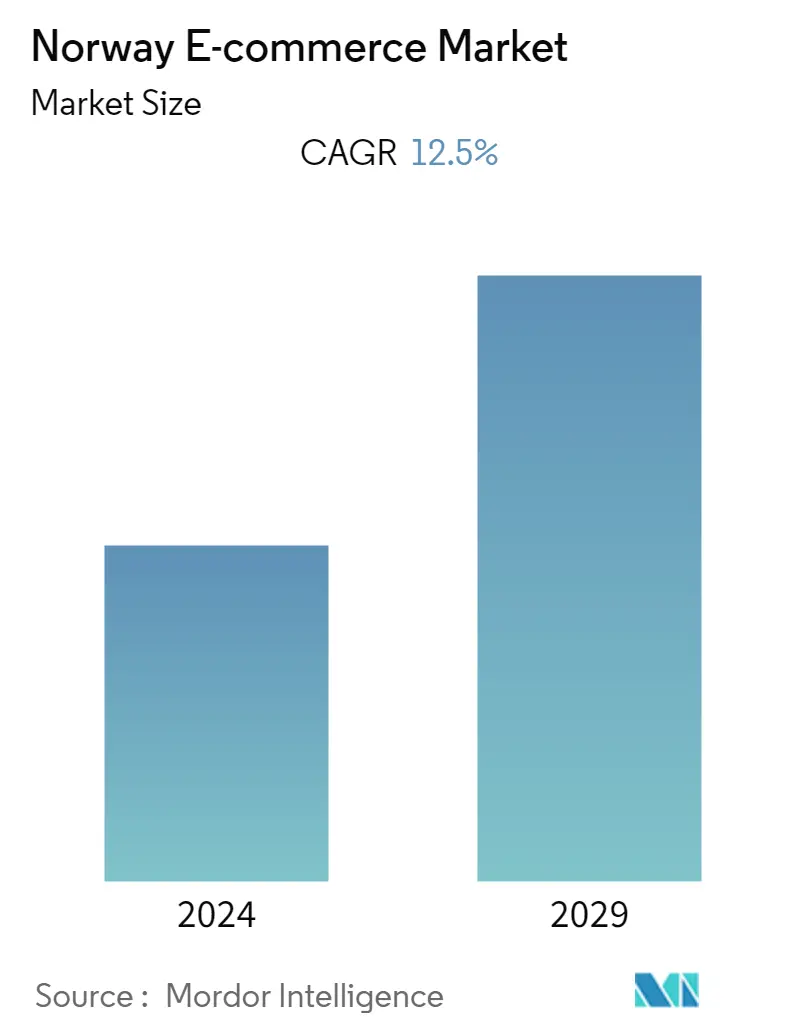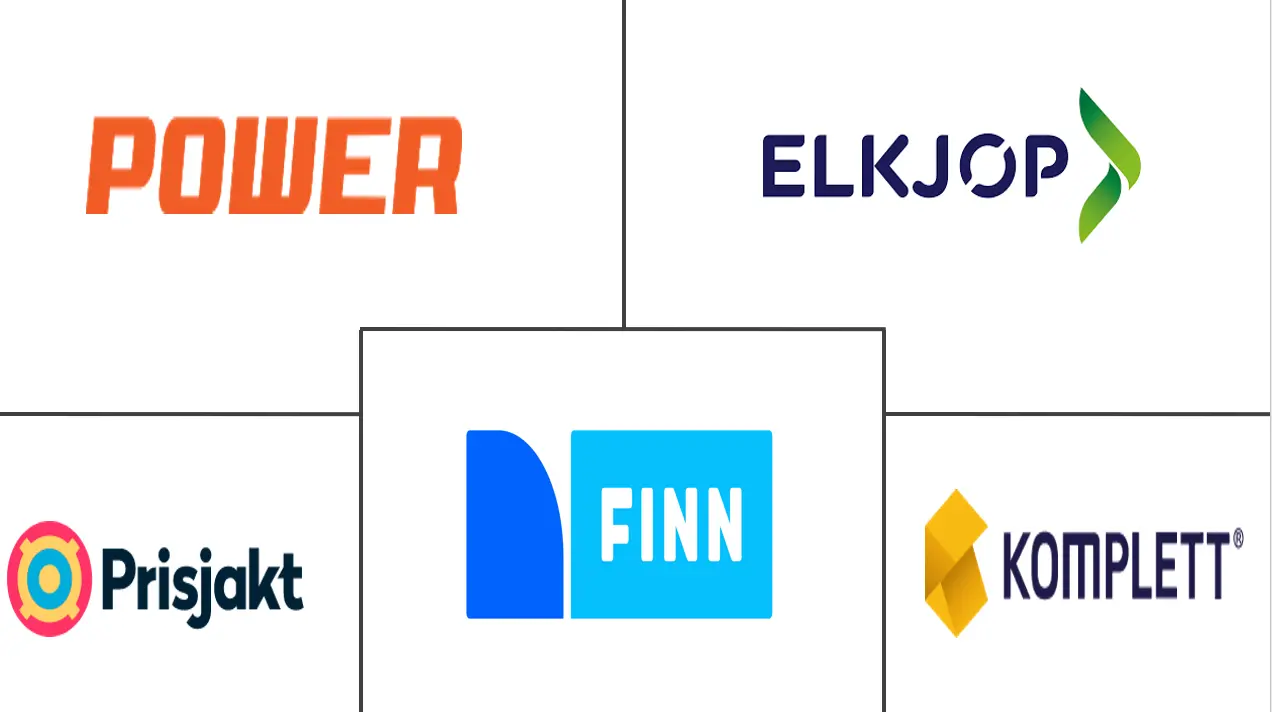Market Size of Norway E-commerce Industry

| Study Period | 2019 - 2029 |
| Base Year For Estimation | 2023 |
| Forecast Data Period | 2024 - 2029 |
| Historical Data Period | 2019 - 2022 |
| CAGR | 12.50 % |
| Market Concentration | Low |
Major Players
*Disclaimer: Major Players sorted in no particular order |
Norway E-commerce Market Analysis
The Norway e-commerce market is expected to register a CAGR of 12.5% during the period 2022-2027. The factors driving the market's growth include better quality transport infrastructure, rising urbanization, and high access to the Internet, among others.
- One of the primary factors helping to drive the growth of the e-commerce market in Norway is how easy it is to deliver goods. Norway ranks decently on the World Bank Logistics Performance Index, which indicates its better quality of the transport infrastructure in the country, eases of arranging low-cost shipments, and less timeliness of freight. These factors are poised to drive the growth of the e-commerce market in Norway.
- Moreover, with 82.97% of the population living in an urban area, as reported by the World Bank, Norway remains one of the easiest countries in the world to deliver to. Furthermore, the high internet penetration across urban and rural areas of the country is also propelling the growth of the e-commerce market in the area.
- The market players are committed to continuous innovation and development in the market. For instance, players can be noted to indulge in personalizing the e-commerce experience by integrating artificial intelligence into the platforms. Furthermore, the vendors are leveraging the customer data to understand behavioral patterns and trends in order to make the platforms more customer-friendly.
- Manufacturers, vendors, and retailers considering selling products through the Internet have the opportunity to get in contact with customers more quickly but still need to consider challenges related to fulfillment, shipping, taxes, value-added tax (VAT), and EU regulations in Norway. According to the Digital Service Act, the e-commerce platforms requires to conduct annual risk assessments on the available content through their platform and its effects on fundamental rights, public health, and public security; including algorithms used, advertising, and content; to report information associated with a severe criminal offense and to suspend services that frequently provide illegal content.
- The COVID-19 outbreak accelerated an expansion of e-commerce towards new businesses, customers, and types of products. E-commerce has offered customers access to a variety of products from the convenience and safety of their homes. It has enabled firms to continue operating despite contact restrictions and other confinement measures. In the region, many operators of brick-and-mortar businesses, who often were forced to shut down their physical business completely, are now considering e-commerce an alternative sales channel.
Norway E-commerce Industry Segmentation
E-commerce or electronic commerce is powered by the internet, where consumers can access online stores to browse the products or services and place orders for goods, products, or services via their own devices.
The Norway E-commerce Market is Segmented by B2C eCommerce (Beauty and Personal Care, Consumer Electronics, Fashion and Apparel, Food and Beverage, Furniture and Home), and B2B eCommerce. The study also tracks the key market parameters, underlying growth influencers, and major vendors operating in the industry, which supports the market estimations and growth rates over the forecast period. The study further analyzes the overall impact of Covid-19 on the ecosystem.
| By B2C ecommerce | ||||||||
| Market Size (GMV) for the Period of 2017-2027 | ||||||||
|
| By B2B ecommerce | |
| Market Size for the Period of 2017-2027 |
Norway E-commerce Market Size Summary
The e-commerce market in Norway is experiencing significant growth, driven by factors such as improved transport infrastructure, high urbanization, and extensive internet access. The country's logistics performance and urban density facilitate efficient and cost-effective delivery of goods, making it an attractive market for e-commerce expansion. The high penetration of the internet, both in urban and rural areas, further supports the proliferation of online shopping. Market players are focusing on innovation, leveraging artificial intelligence to enhance customer experiences and utilizing data analytics to understand consumer behavior better. Despite the opportunities, businesses must navigate challenges related to fulfillment, shipping, and regulatory compliance, including the Digital Service Act's requirements.
The COVID-19 pandemic has accelerated the shift towards e-commerce, with many traditional retailers adopting online sales channels to maintain operations during lockdowns. The increasing confidence of consumers in online shopping, coupled with the widespread use of social media for product promotion, has contributed to the sector's growth. Payment methods like credit and debit cards remain popular, supported by rewards and rebates. The market is characterized by a high level of competition, with major players engaging in strategic collaborations and acquisitions to expand their market share. The online purchase of electronics and media is particularly prevalent among younger consumers, and this trend is expected to continue as digital advertising and advanced e-commerce platforms evolve.
Norway E-commerce Market Size - Table of Contents
-
1. MARKET INSIGHTS
-
1.1 Market Overview
-
1.2 Industry Attractiveness - Porter's Five Forces Analysis
-
1.2.1 Bargaining Power of Suppliers
-
1.2.2 Bargaining Power of Buyers/Consumers
-
1.2.3 Threat of New Entrants
-
1.2.4 Threat of Substitute Products
-
1.2.5 Intensity of Competitive Rivalry
-
-
1.3 Key Market Trends and Share of E-commerce of Total Retail Sector
-
1.4 Impact of COVID-19 on the E-commerce Sales
-
-
2. MARKET SEGMENTATION
-
2.1 By B2C ecommerce
-
2.1.1 Market Size (GMV) for the Period of 2017-2027
-
2.1.2 Market Segmentation - by Application
-
2.1.2.1 Beauty and Personal Care
-
2.1.2.2 Consumer Electronics
-
2.1.2.3 Fashion and Apparel
-
2.1.2.4 Food and Beverages
-
2.1.2.5 Furniture and Home
-
2.1.2.6 Others (Toys, DIY, Media, etc.)
-
-
-
2.2 By B2B ecommerce
-
2.2.1 Market Size for the Period of 2017-2027
-
-
Norway E-commerce Market Size FAQs
What is the current Norway E-commerce Market size?
The Norway E-commerce Market is projected to register a CAGR of 12.5% during the forecast period (2024-2029)
Who are the key players in Norway E-commerce Market?
Prisjakt Sverige AB, Elkjøp, FINN.no, Komplett AS and Power.no are the major companies operating in the Norway E-commerce Market.

